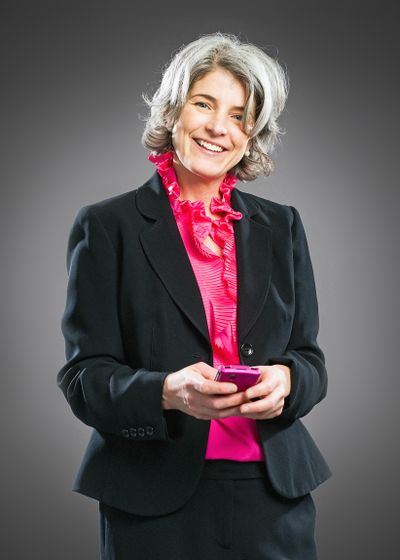Graying of workforce becomes tricky issue

NEW YORK – Jeanne Thompson began going gray at 23. She colored her hair for years as she worked her way into management at a large Boston-area financial services company, then gave up the dye for good about a year ago.
The earth didn’t shake, and the 44-year-old Thompson was promoted to top management the following year.
She is among a new type of gray panther, a woman who aspires to do well and get ahead on the job while happily maintaining a full head of gray.
“Women put pressure on themselves to color,” the Exeter, N.H., woman said. “It’s a bold statement to be gray because it’s saying, ‘You know what? I did let my hair go, but I’m not letting myself go.’ People take me more seriously now. I never apologize for the gray hair.”
But not everyone finds it so easy.
Laws, of course, exist to ward off discrimination in the workplace, yet legions of men and women have no interest in letting their gray fly. Not now, when the struggling economy has produced a stampede of hungry young job-seekers.
But gray heads have been popping up on runways and red carpets, on models and young celebrities for months. There are Lady Gaga and Kelly Osbourne – via dye – and Hollywood royalty like Helen Mirren, the Oscar-winning British actress.
Christine Lagarde, the International Monetary Fund chief, is one of the most powerful women in the world, and she keeps her hair gray. So does Essie Weingarten, founder and now creative director of the nail polish company Essie Cosmetics.
For regular working women, it’s a trickier issue.
“I don’t think a woman in the workplace is going to follow that trend,” David Scher, a civil rights attorney in Washington, said with a laugh. “I think women in the workplace are highly pressured to look young. If I were an older working person, the last thing I would do is go gray.”
Yes, he’s a dude, and at 44 he has virtually no salt in his hair, but he wasn’t alone in issuing a warning against workplace gray for women.
“While the Age Discrimination in Employment Act of 1967 was created to protect employees 40 years of age and older, some men and women may still encounter ageism in the workplace,” said Stephanie Martinez Kluga, a manager for Insperity, a San Antonio-based company that provides human resources services to small and medium-size businesses.
“The long-standing perception that men with gray hair are experienced and women with gray hair are simply old may still be an issue that affects employees in workplaces across the U.S.,” she said.
Some of today’s new gray panthers also offer strong words of caution about exactly how well those anti-discrimination laws work.
Anne Kreamer is gray and proud, but she didn’t unleash the color until she left her day job to become self-employed. She dedicates an entire chapter of her 2007 book “Going Gray” to workplace issues.
“We only fool ourselves about how young we look with our dyed hair,” said the Harvard-educated Kreamer, a former Nickelodeon executive who helped launch the satirical magazine Spy before writing the book exploring her journey to silver.
When it comes to gray on the job, Kreamer said, context counts. The color might be easier in academia over high-tech, for instance, and in Minneapolis over Los Angeles. Job description and your rung on the ladder might also be in play: chief financial officer versus a lowlier, more creative and therefore more gray-tolerant position like assistant talent agent, for example.
Kreamer dubbed the largely unspoken phenomenon “hair-colorism.”
In 1950, 7 percent of women dyed their hair, she said. Today, it’s closer to 95 percent or more, depending on geographic location. In the ’60s, easy, affordable hair dye in a box hit store shelves, changing the follicle landscape for good.
Sandra Rawline, 52, of Houston knows how complicated it can be.
A trial is scheduled for June in her federal lawsuit accusing her boss at Capital Title of Texas of ordering her to dye her gray hair in 2009, when her office moved to a swankier part of town. The suit accuses him of instructing her to wear “younger, fancier suits” and lots of jewelry, according to the Houston Chronicle.
Rawline, an escrow officer and branch manager, wouldn’t comment for this story. The newspaper said her superior called her lawsuit preposterous.
The reason we know about Rawline and Lagarde and Weingarten and Mirren and — let’s throw in NBCUniversal exec Lauren Zalaznick — is that their gray strands stand out against a sea of, well, not gray.
Weingarten, 62, began going gray at 18 and said she colored for years. She gave it up about 20 years ago.
“People would say, ‘Are you crazy? You have to color your hair,’ ” she said. “I had my own business. I was an entrepreneur. I could do whatever I wanted, but the truth is I know a lot of women who are petrified to show gray hair because it means they’re maturing.”
The new “gray movement” doesn’t keep tabs on membership, but blogs like Terri Holley’s Going Gray are proliferating, along with pro-gray Facebook fan pages and Twitter feeds.
“Society has boxed in women on what’s considered to be beautiful, and this defies how we’re supposed to look,” Holley said. “People say, ‘I’m so glad I found you. I’m so glad we’re having this conversation.’ ”